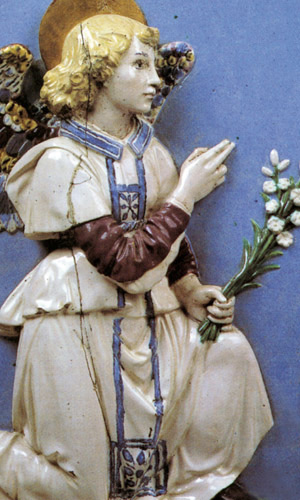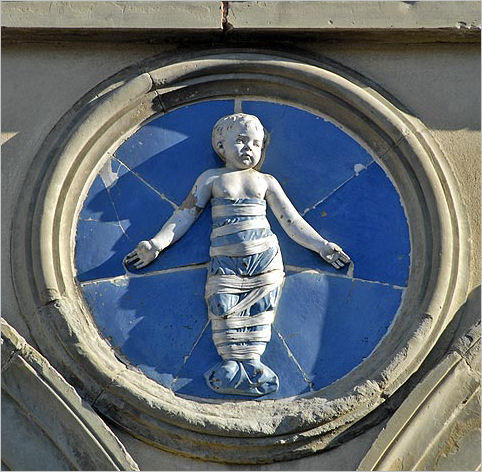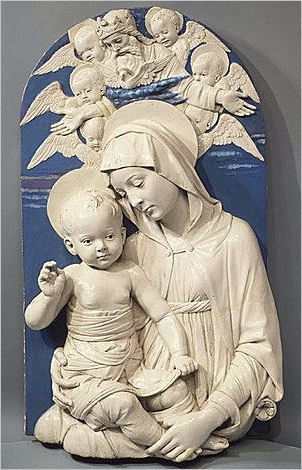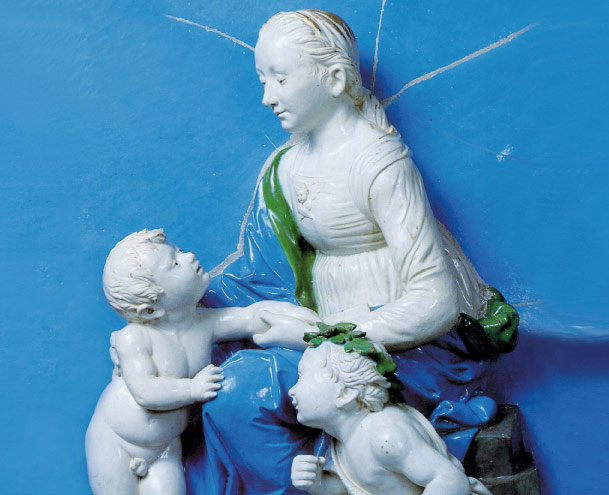 In 1471 Luca della Robbia bequeathed his successful factory to his nephew Simone. He didn’t trust Andrea (1435-1525), whom he believed too concentrated on getting the highest revenue from the family business.
In 1471 Luca della Robbia bequeathed his successful factory to his nephew Simone. He didn’t trust Andrea (1435-1525), whom he believed too concentrated on getting the highest revenue from the family business.
Actually, he was more or less right, if we consider that after his death Andrea massively increased the production of glazed terracotta. However the quality of the pieces did not suffer
much from it. At least in the beginning.
Andrea was a very good artist with a businessman approach to what he considered the family “company”: he increased the number of subjects so as to please both Catholic institutions and laical Customers who favored his glazed terra-cotta, that – if not cheaper than marble – was by far easier to ship and install.
His works were much richer in colors than Luca’s ones. He favored the pictorial impact of glazed terracotta, maybe finding his inspiration in Filippino Lippi’s paintings.
In 1487 he made the eight medallions  for the façade of the Foundling Hospital in Florence. Known as the Hospital of the Innocents, the institution was supported by the authority of the Medici, who encouraged the beginning of Pediatrics. Indeed, one of Andrea’s swaddled infants was chosen as the logo of the American Academy of Pediatrics in 1930. These medallions, together with the Crucifixion and the Assumption of the Virgin at La Verna and the reliefs for the Church of Madonna della Quercia in Viterbo are among Andrea’s most noticeable works.
for the façade of the Foundling Hospital in Florence. Known as the Hospital of the Innocents, the institution was supported by the authority of the Medici, who encouraged the beginning of Pediatrics. Indeed, one of Andrea’s swaddled infants was chosen as the logo of the American Academy of Pediatrics in 1930. These medallions, together with the Crucifixion and the Assumption of the Virgin at La Verna and the reliefs for the Church of Madonna della Quercia in Viterbo are among Andrea’s most noticeable works.
Particularly interesting is the relief of the Meeting of S. Francis and S. Dominic in the Loggia of S. Paul in Florence (1490-95). It‘s a tribute to Savonarola’s attempt to give a serious answer to the moral, religious and political decline afflicting the contemporary society. In line with the new artistic trends, he simplified his sculptural compositions while increasing their emotional impact.
 At the end of the 15th century the huge number of orders forced Andrea to hire more and more workers and to standardize the production process. At this point in time it doesn’t make much sense to try and attribute the family works.
At the end of the 15th century the huge number of orders forced Andrea to hire more and more workers and to standardize the production process. At this point in time it doesn’t make much sense to try and attribute the family works.
Andrea della Robbia died in Florence in 1525, leaving five of his twelve sons and daughters to carry on the family business, which by and large gradually lost inspiration and power.
Despite that, some of Giovanni, Luca the Younger and Girolamo’s achievements deserve to be mentioned.
Giovanni (1469-1529/30) was the one who managed to keep Della Robbia’s production in line with the artistic trends of his time: bright and lively colors with a taste for antique models and monumental sizes. His vases, plates and decoration pieces were works of great merit.
Giovanni’s largest and perhaps finest works are the medallions for the Hospital del Ceppo in Pistoia. They were sculpted in high relief, well modeled and designed, but somewhat diminished by the crudeness of some of their coloring.
Luca the Younger (1475-1548) was, according to Vasari, a refined sculptor, very good in the family technique. Pope Leone X asked him to make the tiled pavement for Raphael’s Loggia at the Vatican. He made finely designed and painted majolica tiles.
 Girolamo (1488 – 1566) worked with Luca the Younger in the Certosa of Florence and, like his brother, he was very much influenced by Raphael, Sansovino and Andrea del Sarto. He went to France in 1517, where he spent the rest of his life, also taking part in the decoration of Fontainebleau.
Girolamo (1488 – 1566) worked with Luca the Younger in the Certosa of Florence and, like his brother, he was very much influenced by Raphael, Sansovino and Andrea del Sarto. He went to France in 1517, where he spent the rest of his life, also taking part in the decoration of Fontainebleau.
After Girolamo the contribution of the Della Robbia family to Art ceased. Their fame, however, is still intact, just like the beauty of their works.

Hi Brogam
sorry for being late in answering your message. We used several sources actually, art magazines and catalogues, among them two exhibition catalogues both titled “I Della Robbia”, one published by Skira, the other by Scala. Hope this helps. Good luck with your paper.
To whom it may concern:
I am writing a paper on Andrea Della Robbia and am wondering if you can give me the source to where you gained the information on this blog entry.
Thanks,
Brogan